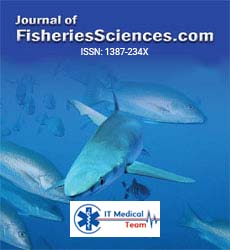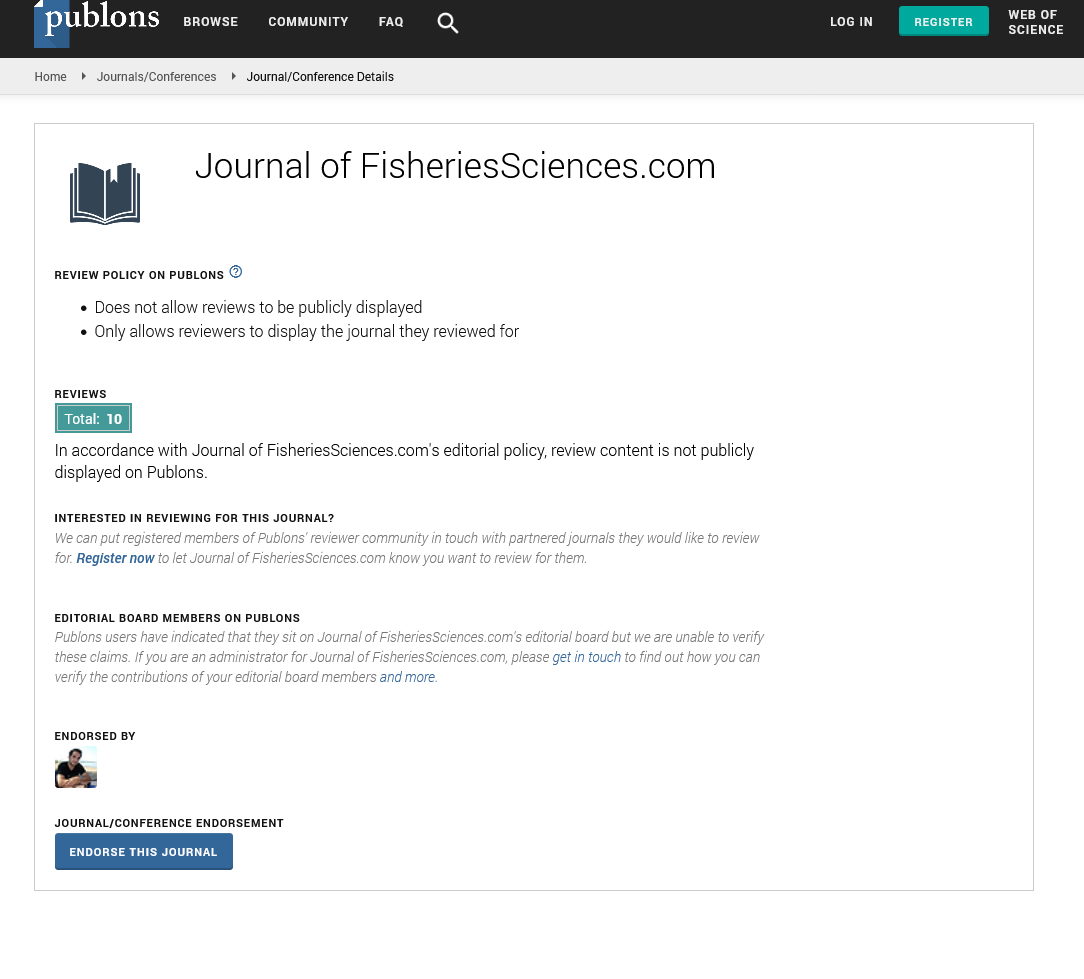Perspective - (2024) Volume 18, Issue 6
Advancements in Fisheries Technology: Shaping the Future of Sustainable Aquatic Management
Margerite Irvin*
Department of Biology and Ecology of Fishes, University of AquaScience, Cali, Colombia
*Correspondence:
Margerite Irvin, Department of Biology and Ecology of Fishes, University of AquaScience, Cali,
Colombia,
Email:
Received: 03-Dec-2024, Manuscript No. IPFS-24-15413;
Editor assigned: 06-Dec-2024, Pre QC No. IPFS-24-15413 (PQ);
Reviewed: 20-Dec-2024, QC No. IPFS-24-15413;
Revised: 23-Dec-2024, Manuscript No. IPFS-24-15413 (R);
Published:
31-Dec-2024
Introduction
Fisheries technology has undergone remarkable
advancements in recent decades, revolutionizing how we
manage aquatic resources and ensuring sustainability. As global
demand for seafood increases, effective management and
innovative technological solutions are essential for maintaining
healthy fish populations and preserving aquatic ecosystems. This
article explores key advancements in fisheries technology,
including monitoring systems, fishing gear innovations and data
analytics and examines their impact on sustainable fisheries
management.
Description
Monitoring systems: Enhancing data collection and
management
One of the most significant advancements in fisheries
technology is the development of sophisticated monitoring
systems. Traditional methods of data collection, such as manual
surveys and observer programs, are being supplemented or
replaced by advanced technologies that offer real-time data and
increased accuracy.
Satellite and remote sensing technology: Satellite technology
has transformed fisheries monitoring by providing
comprehensive and real-time data on sea surface temperatures,
chlorophyll concentrations and ocean currents. These
parameters are crucial for understanding fish distribution and
predicting fishery yields. For instance, satellite-based remote
sensing can track the movement of fishing vessels, monitor
illegal fishing activities and assess the health of marine
ecosystems. This technology allows for more informed decisionmaking
and enhances regulatory enforcement.
Electronic monitoring systems: Electronic monitoring
systems, including underwater cameras and sensors, are
increasingly used to observe and record fishing activities. These
systems provide high-resolution imagery of fish behavior,
bycatch and the overall impact of fishing practices. This data is
invaluable for assessing compliance with regulations and for
refining fishing practices to minimize bycatch and habitat
damage.
Innovations in fishing gear: Reducing environmental
impact
Technological advancements in fishing gear play a crucial role
in reducing the environmental impact of fishing operations.
Innovations aim to improve selectivity, minimize bycatch and
decrease habitat disturbance.
Selective fishing gear: Selective fishing gear, such as modified
nets and traps, is designed to target specific species while
reducing the capture of non-target species. For example, Bycatch
Reduction Devices (BRDs) and escape panels allow non-target
species to escape from trawl nets, thereby decreasing bycatch
rates. Similarly, circle hooks and specialized gear reduce the
mortality of non-target species like sea turtles and seabirds.
Sustainable aquaculture technologies: Aquaculture or fish
farming, has also seen significant technological improvements
aimed at enhancing sustainability. Recirculating Aquaculture
Systems (RAS) are one such advancement. RAS technology
recycles water within the system, minimizing water use.
Additionally, innovations in feed formulations, such as plant-based
feeds and insect meal, help reduce the reliance on wild-caught fish
for feed, thereby alleviating pressure on natural fish stocks.
Data analytics and modeling: Improving fisheries
management
The integration of data analytics and modeling into fisheries
management has revolutionized how we understand and
manage fish populations. These tools enable scientists and
managers to analyze complex datasets, predict future trends and
make informed decisions.
Ecosystem-based management models: Ecosystem-Based
Management (EBM) models take a holistic approach to fisheries
management by considering the interactions between fish
populations, their habitats and other components of the
ecosystem. Advanced modeling techniques simulate various
management scenarios, helping policymakers evaluate the
potential impacts of different strategies on ecosystem health
and fishery sustainability.
Artificial intelligence and machine learning: Artificial
Intelligence (AI) and machine learning algorithms are increasingly used to analyze vast amounts of data generated by monitoring
systems and electronic devices. These technologies can identify
patterns and trends that might be missed through traditional
analysis methods. For example, AI algorithms can process
underwater imagery to identify fish species and estimate
population sizes, enhancing stock assessment accuracy.
Challenges and future directions
Despite the significant advancements in fisheries technology,
challenges remain in achieving sustainable fisheries
management. Technological solutions must be complemented
by effective policies, international cooperation and community
engagement. Additionally, there is a need for ongoing research
to address emerging issues such as climate change, which
impacts fish distributions and marine ecosystems.
Conclusion
The field of fisheries technology is rapidly evolving, offering
new tools and methods to address the complex challenges of
managing aquatic resources sustainably. From advanced
monitoring systems and selective fishing gear to data analytics
and modeling, these technological advancements are shaping
the future of fisheries management. As we continue to innovate
and refine these technologies, it is crucial to ensure that they are
used effectively and equitably to promote the health of our
oceans and the sustainability of global fish stocks. Through
continued research, collaboration and adaptive management,
we can work towards a future where fisheries remain productive
and resilient for generations to come.
Citation: Irvin M (2024) Advancements in Fisheries Technology: Shaping the Future of Sustainable Aquatic Management. J Fish Sci. Vol.18 No.6






